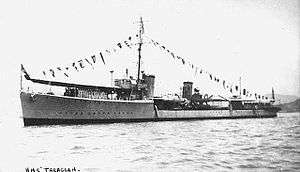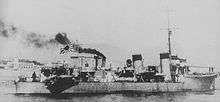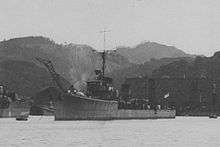HMS Thracian (1920)
HMS Thracian was an S-class destroyer built for the Royal Navy during the First World War.
 HMS Thracian in 1941 | |
| History | |
|---|---|
| Name: | HMS Thracian (D86) |
| Ordered: | 1915 |
| Builder: | |
| Laid down: | 17 January 1918 |
| Launched: | 5 March 1920 |
| Commissioned: | 1 April 1922 |
| Fate: | Grounded on 25 December 1941 at Aberdeen, Hong Kong |
| General characteristics HMS Thracian | |
| Class and type: | S-class destroyer |
| Displacement: | 1,075 long tons (1,092 t) |
| Length: | 276 ft (84 m) o/a |
| Beam: | 26 ft 8 in (8.13 m) |
| Draught: | 9 ft (2.7 m) |
| Installed power: |
|
| Propulsion: | 2 Shafts; 2 steam turbines |
| Speed: | 36 knots (67 km/h; 41 mph) |
| Range: | 2,750 nmi (5,090 km; 3,160 mi) at 15 knots (28 km/h; 17 mph) |
| Complement: | 90 |
| Armament: |
|
| Name: |
|
| Builder: | Navy 2nd Construction Department at Hong Kong |
| Acquired: | 1942 |
| Commissioned: | 1 October 1942 |
| Decommissioned: | 1945 |
| In service: | 1942-1945 |
| Renamed: |
|
| Reclassified: | Training ship, 15 March 1944 |
| Reinstated: | Returned to Royal Navy in October 1945 |
| Fate: | Scrapped, February 1946 |
| General characteristics Patrol Boat No.101 | |
| Class and type: | Patrol boat/Training ship |
| Displacement: | 1,150 long tons (1,168 t) standard |
| Length: | 80.79 m (265 ft 1 in) Lpp |
| Beam: | 8.17 m (26 ft 10 in) |
| Draft: | 3.01 m (9 ft 11 in) |
| Propulsion: |
|
| Speed: | 25 knots (29 mph; 46 km/h) |
| Complement: |
|
| Sensors and processing systems: | Mk. 23 gunfire control radar (1944) |
| Armament: |
|
Description
The S-class destroyers were improved versions of the preceding Modified R class. They displaced 1,075 long tons (1,092 t).[1] The ships had an overall length of 276 feet (84.1 m), a beam of 26 feet 8 inches (8.1 m) and a draught of 9 feet (2.7 m). They were powered by two Brown-Curtis geared steam turbines, each driving one propeller shaft, using steam provided by two Yarrow boilers. The turbines developed a total of 27,000 shaft horsepower (20,000 kW) and gave a maximum speed of 36 knots (67 km/h; 41 mph). The ships carried a maximum of 301 long tons (306 t) of fuel oil that gave them a range of 2,750 nautical miles (5,090 km; 3,160 mi) at 15 knots (28 km/h; 17 mph). The ships' complement was 90 officers and ratings.[2]
Thracian was armed with three QF 4-inch (102 mm) Mark IV guns in single mounts and a single 2-pounder (40 mm) "pom-pom" anti-aircraft gun. The ship was fitted with two twin mounts for 21-inch (533 mm) torpedoes.[1] Two additional single mounts were positioned abreast the bridge at the break of the forecastle for 18-inch (45 cm) torpedoes. All torpedo tubes were above water and traversed to fire.[3]
Construction and career
HMS Thracian was laid down on 17 January 1918 at Hawthorn Leslie and Company, launched on 5 March 1920 and completed at Sheerness Dockyard on 1 April 1922. The ship was run aground and scuttled at Hong Kong on 25 December 1941, later captured by the Imperial Japanese Army.
Imperial Japanese Navy service (1942 – 1945)


- 1 October 1942: Registered to naval ship list in the Imperial Japanese Navy, and classification to the Special service ship (Patrol boat). Renamed
Patrol Boat No. 101.
- 25 November 1942: Repairs were completed by the Navy 2nd Construction Department, and assigned to the Yokosuka Naval District.
- (after): She spent her time on convoy escort operations in the Yokosuka Area.
- 15 August 1943: Assigned to the Torpedo warfare school (Yokosuka).
- 15 March 1944: Classification to the miscellaneous ship (Training ship), and renamed Special Training Ship No. 1. She was used for a test bed for new weapons.
- 15 August 1945: Survived war at Yokosuka.
- October 1945: Returned to Royal Navy.
- February 1946: Scrapped at Hong Kong.
Notes
- Gardiner & Gray, pp. 84–85
- Lenton, p. 137
- Friedman, p. 169
Bibliography
- Colledge, J. J.; Warlow, Ben (2006) [1969]. Ships of the Royal Navy: The Complete Record of all Fighting Ships of the Royal Navy (Rev. ed.). London: Chatham Publishing. ISBN 978-1-86176-281-8.
- Dittmar, F.J. & Colledge, J.J. (1972). British Warships 1914–1919. Shepperton, UK: Ian Allan. ISBN 0-7110-0380-7.
- Friedman, Norman (2009). British Destroyers: From Earliest Days to the Second World War. Barnsley, UK: Seaforth Publishing. ISBN 978-1-84832-049-9.
- Gardiner, Robert & Gray, Randal (1985). Conway's All The World's Fighting Ships 1906–1921. London: Conway Maritime Press. ISBN 0-85177-245-5.
- Lenton, H. T. (1998). British & Empire Warships of the Second World War. Annapolis, Maryland: Naval Institute Press. ISBN 1-55750-048-7.
- March, Edgar J. (1966). British Destroyers: A History of Development, 1892–1953; Drawn by Admiralty Permission From Official Records & Returns, Ships' Covers & Building Plans. London: Seeley Service. OCLC 164893555.
Further reading
- Rekishi Gunzō, History of Pacific War Vol.45, Truth histories of the Imperial Japanese Naval Vessels, Gakken (Japanese publisher), May 2004, ISBN 4-05-603412-5.
- Ships of the World, special issue Vol.45, Escort Vessels of the Imperial Japanese Navy, "Kaijinsha"., (Japan), 1996.
- The Maru Special, Japanese Naval Vessels No.49, "Japanese submarine chasers and patrol boats", "Ushio Shobō". (Japan), 1981.